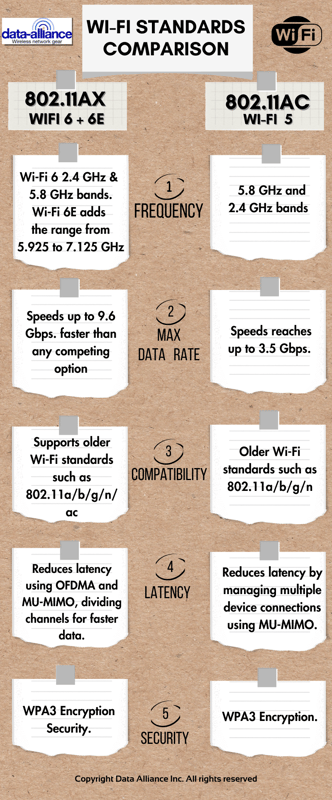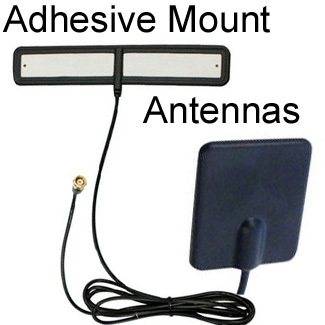WiFi 6 & 6E Antennas

Wi-Fi 6 and 6E:
Key Features, Differentiators and Applications
Wi-Fi 6 is the sixth iteration of the Wi-Fi wireless local area networking standard IEEE 802.11ax which was released in late 2019 by the Institute of Electrical and Electronics Engineers. It is the successor of 802.11ac or Wi-Fi 5 that operates in the 6 GHz frequency band. Wi-Fi 6 also known as High-Efficiency Wi-Fi and has several distinctive features that boost the quality and performance of its connectivity in high-density environments. A range of newly released hardware certifications partner with the release of the Wi-Fi 6 networking protocol to ensure that products are truly Wi-Fi 6 compliant and deliver the full range of features to their owners. Wi-Fi 6 is fully backward-compatible with previous versions of Wi-Fi.
Wi-Fi version 6, also known as IEEE 802.11ax was finally approved, after previous drafts of the standard having been rejected, in February 2021, being released at the end-of-year. Wi-Fi 6 is expected to have a transformative effect on the speed and performance of this popular wireless local area networking (WLAN) technology, it is important to remember that Wi-Fi 6 will have the same basic functionality as previous versions of Wi-Fi. In this concise guide, we provide you with all the essential details on the Wi-Fi 6 release and what is advantageous about the new generation of Wi-Fi.
What is different about Wi-Fi 6?
Wi-Fi 6 is expected to improve the end-user experience with this wireless networking technology, quadrupling the throughput per area in busy environments like offices, malls, and condominiums where user demand and density are high. The limited scalability of Wi-Fi has been a notable limitation, but Wi-Fi 6 uses new technologies and networking strategies to, potentially, finally overcome this longstanding challenge.
Six key features of Wi-Fi 6:
1. The frequency bands
Like the previous versions of Wi-Fi, Wi-Fi 6 continues to operate in unlicensed frequency bands. Wi-Fi 6 not only operates in the 2.4 and 5 GHz bands but can also take advantage of a much larger portion of the spectrum between 5.925–7.125 GHz, also known as the 6 GHz frequency band. The 6 GHz band has seven non-overlapping channels with generous 160 MHz channel widths that improve speed and latency.
At 2.4 and 5 GHz, Wi-Fi 6 divides the combined bandwidth into up to 256 subchannels to reduce interference and frequency-dependent fading. Sub-channels are no longer run in parallel but are utilized according to resource units (RUs) that can serve multiple clients simultaneously allocating bandwidth to specific functions rather than specific clients.
The FCC allocated the 6 GHz frequency band for Wi-Fi on the condition that a frequency selection system is implemented to manage the spectrum and minimize interference. The FCC has called for an automated frequency coordination (AFC) system to be devised to manage the use of the 6 GHz band.
What is automated frequency coordination (AFC)?
Automated frequency coordination is the software algorithm-mediated control of access to portions of the radio spectrum to prevent harmful interference. It is a solution that has been developed to alleviate the pressures on the radio spectrum as demand for wireless connectivity has increased and regulators turn to spectrum sharing strategies as a means of using spectrum allocations more effectively.
Multiple groups are working towards the development of open-source and proprietary AFC systems for Wi-Fi and other wireless networking technologies. Tenders have already been submitted to the FCC by companies like Google and Sony to develop to become AFC operators.
3. Modulation Technologies
Wi-Fi 6 achieves the uplift in performance not only by increasing bandwidth but also by using different types of modulation. The use of multi-user orthogonal frequency-division multiple access (MU-OFDMA), a modulation technique used in cellular networking, enhances the spectral efficiency Wi-Fi.
4. MIMO
The Wi-Fi Alliance also improved the spectrum utilization of Wi-Fi 6 by using MIMO. Wi-Fi 6 routers are carrying up to eight antennas. This antenna diversity scheme improves the throughput of Wi-Fi 6 and protects networks against interference, further improving the overall efficiency. Further enhancement to the MIMO technology used in Wi-Fi 6 is expected with updates to the newly released standard (Wave 2).
5. Speed and Latency
Wi-Fi 6 delivers a 37% uplift in data rate. Though the increase in speed is not dramatic, it is part of a constellation of improvements that deliver an overall significant increase in efficiency, as much as 300%.The latency of Wi-Fi 6 is 75% lower than Wi-Fi 5 while delivering 4 times the data to multiple clients.
6. Target Wake Time (TWT) helps to decrease power consumption
TWT technology is a new addition to the WiFi 6 protocol and enables client devices to negotiate wake-up times with their access points. This means that the access points can aggregate the activity with client devices into specific periods, saving energy for both the devices and the access point.
Wi-Fi 6 is positioned to be IoT-friendly
Wi-Fi has been limited in its performance as an IoT networking technology because it can’t support large numbers of device connections. WiFi does not have the low-energy and long-distance advantages of LoRaWAN or the protection against interference of cellular networks that operate in the licensed spectrum, which often makes it a less competitive choice for IoT deployments.
The improvements of Wi-Fi 6 go a long way to increasing the capacity of Wi-Fi networks, with the TWT technology reducing energy consumption to a level where battery-operated nodes can be supported by Wi-Fi successfully.







